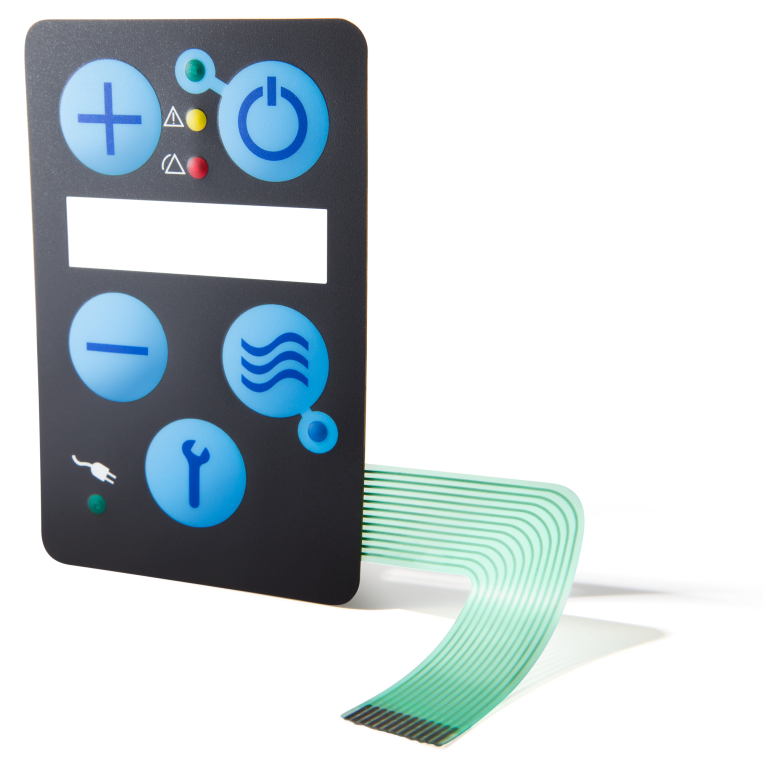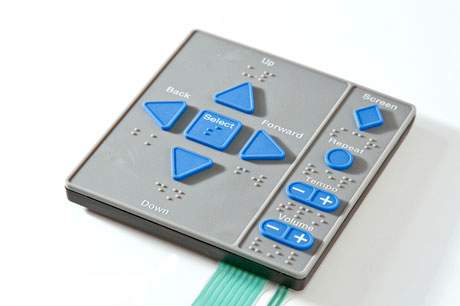Membrane Switch Manufacturer Offering Advanced Engineering Solutions
Membrane Switch Manufacturer Offering Advanced Engineering Solutions
Blog Article
Exploring the Manufacturing Process of Membrane Switch for Numerous Industries
The manufacturing procedure of Membrane switches is a complex endeavor that requires precision and attention to detail. From selecting ideal products to carrying out extensive quality control actions, each action plays an important role in ensuring performance. Different industries, consisting of clinical and automotive, rely upon these components for their unique applications. Comprehending the ins and outs of this process reveals considerable insights into how these buttons are produced and their impact across varied industries.
Understanding Membrane Switches: A Review

Trick Materials Made Use Of in Membrane Switch Production
In Membrane switch manufacturing, the option of key products significantly influences performance and resilience. Conductive products, adhesives, and layers play vital functions, while substrate option affects total performance and integrity. Recognizing these elements is crucial for maximizing the style and production of Membrane buttons.
Conductive Products Overview
Conductive materials play a crucial duty in the capability of Membrane switches, making certain trusted electrical connections within the tool. Generally made use of materials consist of silver, copper, and carbon-based inks, each offering unique benefits. Silver is favored for its high conductivity and sturdiness, making it ideal for applications needing durable performance. Copper, while slightly much less conductive than silver, is a cost-efficient choice often used in printed circuits. Carbon-based inks supply a versatile alternative, suitable for applications where adaptability and reduced prices are prioritized, although they have actually reduced conductivity contrasted to metal choices. The selection of conductive products straight influences the overall reliability, lifespan, and performance of the Membrane switch, making it an important consideration in the production procedure.
Adhesives and Coatings
Adhesives and coatings are essential components in the manufacturing of Membrane switches, supplying essential bonding and safety homes. These materials assure that various layers of the switch, consisting of graphic overlays and wiring, stick securely to each other, enhancing toughness and capability. Typically utilized adhesives consist of pressure-sensitive adhesives (PSAs) and epoxy-based formulas, which supply solid attachment and strength. Coatings, such as polyurethane or acrylic, serve to shield against ecological factors, including dampness, abrasion, and chemicals. Furthermore, coatings can improve responsive responses and visual allure, adding to the overall customer experience. The choice of appropriate adhesives and finishings is crucial for enhancing performance and longevity in diverse applications throughout numerous industries, ensuring that Membrane switches satisfy details operational demands.
Substrate Selection Elements
Substrate selection plays an important role in the production of Membrane switches, as it substantially influences their total efficiency and sturdiness. Key products such as polyester, polycarbonate, and versatile printed motherboard (FPCBs) are typically made use of for their unique buildings. Polyester is favored for its cost-effectiveness and resistance to abrasion, making it ideal for applications with high wear. Polycarbonate deals premium clearness and influence resistance, perfect for environments requiring high visibility. FPCBs supply improved flexibility and are usually made use of in complex layouts. The selection of substratum likewise influences variables like thermal security, chemical resistance, and ease of printing. Inevitably, picking the ideal substrate is vital for ensuring the performance and long life of Membrane changes across numerous industries.
The Layout Refine of Membrane Changes
The design process of Membrane switches is a crucial stage that greatly affects the capability and looks of the end product - membrane switch manufacturer. It starts with defining the certain demands of the application, including measurements, switch design, and responsive responses preferences. Designers have to take into consideration individual communication, ensuring that the button is instinctive and accessible.Next, materials are picked based on toughness, adaptability, and ecological resistance. The assimilation of graphics and branding aspects is likewise vital, as it boosts visual charm and interaction. Prototyping allows for repetitive testing, allowing adjustments based upon customer responses and performance evaluations.Additionally, the design needs to account for the electrical elements, such as ports and circuits, ensuring integrity and convenience of use. Inevitably, an effective layout integrates performance, looks, and individual experience, paving the means for reliable manufacturing and durable efficiency in various industries
Printing Strategies for Membrane Changes
The printing methods made use of in Membrane button manufacturing play an essential function in establishing the end product's high quality and capability. Display printing supplies benefits such as toughness and dynamic shade application, while electronic printing innovations provide versatility and accuracy in style. Recognizing these methods can greatly affect the overall efficiency of Membrane buttons in different applications.
Screen Printing Benefits
Countless advantages make screen printing a recommended technique for generating Membrane buttons. This method permits top quality, detailed layouts and vivid shades, which are important for customer interface applications. Screen printing is particularly reliable for using thick ink layers, improving durability and responsive comments. On top of that, it supplies outstanding adhesion to various substrates, guaranteeing durability sought after environments. The process is affordable for large production runs, as it lessens setup time and waste. Moreover, screen printing supports a large range of inks, including specialized and UV-curable options, allowing versatility in layout. Its ability to generate regular results across several systems makes it a trustworthy option for producers going for top quality anonymous and efficiency in Membrane switch manufacturing.
Digital Printing Innovations

Developments in digital printing innovation are transforming the production of Membrane switches, using manufacturers innovative options that boost style flexibility and effectiveness. Digital printing enables for detailed styles and high-resolution graphics, enabling custom branding and performance without the limitations of typical techniques. This strategy minimizes configuration times and prices, helping with shorter production runs and very little waste, making it perfect for businesses with varying demands. Additionally, improvements in ink solutions give better sturdiness and adhesion, guaranteeing longevity in various atmospheres. As sectors progressively look for personalized and complicated styles, digital printing stands apart as a vital method, establishing a brand-new criterion in Membrane button manufacturing. The assimilation of these technologies placements suppliers to fulfill evolving market requires properly.
Assembly and Layering of Membrane Switch Parts
Mindful setting up and layering of Membrane switch parts are important to ensuring functionality and toughness. This process begins with the exact alignment of numerous layers, including the graphic overlay, sticky, circuit layer, and support material. Each component should be carefully placed to maintain electrical honesty and user interface responsiveness.During assembly, conductive traces are put on the circuit layer, typically made from materials like polyester or polycarbonate. This layer is essential, as it transfers signals when stress is used. The glue utilized for bonding these layers is additionally chosen for its capacity to withstand environmental stresses while preserving a safe bond.Heat and stress are frequently applied throughout the assembly process to ascertain that the layers stick correctly without endangering the performance of the switch. Focus is offered to the edge securing to shield versus moisture and pollutants, protecting the longevity of the Membrane button in various commercial applications.
Quality Assurance Actions in Membrane Switch Production
Quality control measures play a vital duty in ensuring the dependability and efficiency of Membrane changes following the assembly and layering of their elements. In the production procedure, numerous key inspections are conducted to promote high quality criteria. These include aesthetic evaluations for flaws in printing and sticky application, along with functional tests to confirm the responsiveness of each switch.Additionally, ecological screening is performed to analyze the buttons' longevity against temperature changes and moisture direct exposure. Manufacturers frequently implement analytical procedure control (copyright) strategies to check manufacturing uniformity, allowing very early discovery of anomalies.Furthermore, traceability systems are established to track elements and materials, making sure accountability and facilitating remembers if needed. Calibration of tools and adherence to industry criteria are also essential to preserving item integrity. Jointly, these quality assurance procedures protect the efficiency of Membrane switches over throughout different applications, inevitably enhancing customer complete satisfaction.
Applications of Membrane Changes Across Different Industries
Membrane buttons are utilized throughout a varied variety of sectors, showcasing their convenience and adaptability. In the clinical market, they give dependable and water resistant user interfaces for devices such as diagnostic devices and infusion pumps, guaranteeing hygiene and ease of use. The auto market uses Membrane buttons for dashboard controls, enabling smooth interaction between the driver and lorry systems.In customer electronics, these switches are located in devices and handheld tools, supplying a streamlined, modern-day aesthetic while boosting functionality. Industrial applications also leverage Membrane changes for machinery control panels, where toughness and resistance to extreme conditions are essential.Furthermore, the aerospace and protection fields make use of Membrane switches for cabin instrumentation and communication systems, prioritizing dependability and efficiency under extreme conditions. In general, Membrane switches play a critical function in improving the individual experience and operational effectiveness across various domain names.
Regularly Asked Questions
The length of time Does It Require To Make a Membrane Switch?
The production time for a membrane switch usually varies from a few days to numerous weeks - membrane switch manufacturer. Factors influencing this duration consist of style intricacy, material schedule, and manufacturing volume, all impacting the total timeline substantially
What Is the Normal Life-span of a Membrane Layer Switch?
The normal life-span of a membrane layer switch usually varies from 1 to 5 million additional resources actuations, depending upon aspects such as worldly quality, ecological problems, and use frequency, considerably affecting resilience and general performance.
Can Membrane Switches Be Custom-made for Certain Applications?
Membrane switches can indeed be personalized for certain applications. Their style adaptability enables changes in size, form, shades, and graphics, ensuring compatibility with distinct needs across numerous sectors and boosting performance and individual experience.

Are Membrane Switches Eco-friendly?
The ecological effect of Membrane switches over differs. Some materials made use of might not be find here eco-friendly, while innovations in making procedures are progressively concentrating on sustainability, aiming to reduce waste and advertise recyclable components in their production.
What Are the Typical Failing Modes of Membrane Switches?
Common failure modes of Membrane buttons include delamination, sticky failing, wear and tear from usage, moisture ingress, and electrical failings. These issues can considerably affect performance, performance, and lifespan in numerous applications throughout various industries. Membrane buttons can be tailored to fit details design requirements, such as form, dimension, and capability, making them highly adaptable.The construction generally involves several layers, consisting of a visuals overlay, adhesive, and a circuit layer, which work together to create a seamless individual experience. In Membrane button manufacturing, the choice of crucial materials greatly influences performance and toughness. The automobile industry employs Membrane buttons for dashboard controls, making it possible for smooth communication between the motorist and car systems.In customer electronics, these buttons are found in appliances and portable tools, offering a streamlined, modern visual while boosting functionality. Industrial applications likewise utilize Membrane switches for machinery control panels, where toughness and resistance to rough problems are essential.Furthermore, the aerospace and protection sectors use Membrane buttons for cockpit instrumentation and interaction systems, focusing on dependability and performance under extreme conditions. Membrane buttons can certainly be tailored for specific applications.
Report this page